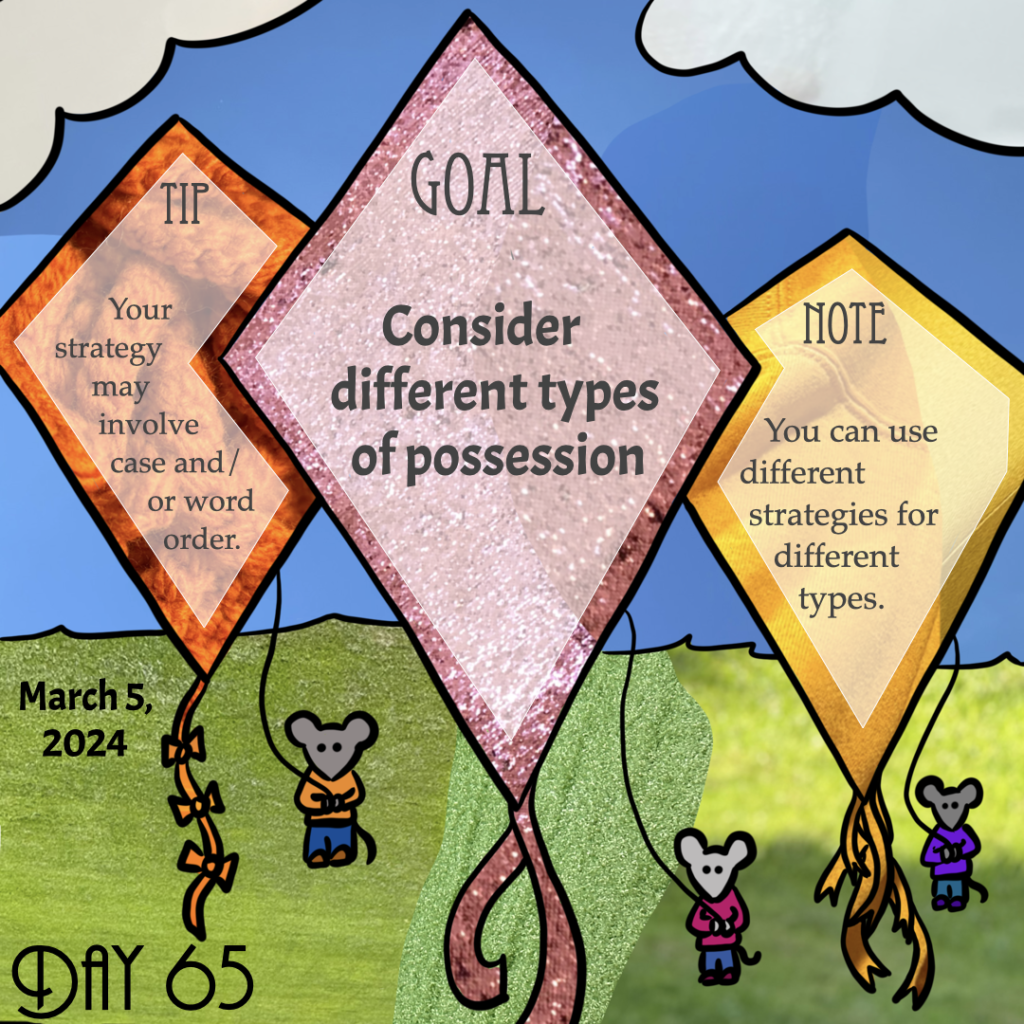
Goal: Consider different types of possession
Note: You can use different strategies for different types.
Tip: Your strategy may involve case and/or word order.
Work focus: Learn/Brainstorm/Try
Some languages distinguish between alienable and inalienable possession, marking those relationships differently. Inalienable possession typically refers to a relationship between possessor and possessed that is a more inherent and less breakable bond. Common examples of inalienable possession include body parts (e.g. the dog’s nose) and kinship terms (e.g. the cat’s mother). Alienable possession covers the types of possession that are more commonly associated with possession, including owned objects (e.g. Sara’s car, Torin’s umbrella, the fox’s den).
One decision you need to make is whether your language will distinguish alienable from inalienable possession and, if so, how. One way you could do that is to have inalienable possession as an unmarked phrase while alienable possession requires the genitive case (or other possessive marker). For instance, let’s say there is a VSO (head-initial) language with these words:
- tol “bear”
- kozu “son”
- uvi “apple”
- -av “genitive”
As a head-initial language, head nouns occur before any modifying words, including a possessor. Further, this language distinguishes alienability, where inalienable possession is unmarked while alienable possession is marked. Therefore, kozu tol (“son bear”) is used to mean “the bear’s son” (where word order determines the relationship) while uvi tolav (“apple bear-of”) is used to mean “the bear’s apple” (where case-marking and word order determine the relationship). Of course, you could also mark both kinds of possession but with different markers.
You should also consider a fuller array of relationships that might be indicated by your possessive construction(s). English uses a possessive construction to indicate a variety of semantic relationships, not all of which are strictly relationships of possession. Consider the following phrases:
- the cow’s leg
- the boy’s rock (the one in his possession that he owns)
- the boy’s rock (the one in the forest that he found and likes to sit on)
- the barn’s roof
- the berry’s color / the berry’s taste
- the stream’s rocks / the stream’s edge
That is to say, English uses a possessive construction to indicate a variety of relationships, including location, parts of a whole, and common associations. (And the examples provided here don’t cover the full range of possibilities!)
Even with a phrase like “Bailey’s book,” which seems like a pretty straightforward phrase, you can get a variety of possible relationships:
- Bailey’s book (the one they bought and own)
- Bailey’s book (the one they wrote but that someone else owns)
- Bailey’s book (the one the library owns but which they borrowed and are reading)
- Bailey’s book (the one I bought for them but have not yet gifted to them)
Not all languages mark all these kinds of relationships with a possessive construction, so that is a decision for you to consider—exactly what relationships your possessive should cover .
